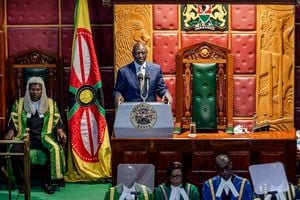Covid-19 fuels hunger in Zimbabwe's urban areas

People queue at a money transfer service in Bulawayo, Zimbabwe, on March 31, 2020.
Zimbabwe has seen a huge a jump in the number of food insecure families in urban areas in the past year with 2.4 million residents now struggling to meet their basic food needs, the World Food Programme (WFP) has warned.
The spike in the number of food insecure people in urban areas has been blamed on lockdowns imposed starting last year to slow down the spread of Covid-19.
A new Zimbabwe Vulnerability Assessment Committee (ZimVac) report says 42 percent of urban households will not be able to meet their cereal requirements this year compared to about 30 percent for the same period in 2019.
“Reduced access to nutritious food has resulted in negative impacts for many,” said WFP country director Francesca Erdelmann
“Families will find it difficult to put food on the table, most of them have been stuck at home and were not able to go to work, the fortunate ones will skip meals while those without will have to go to bed with an empty stomach.
“For the most vulnerable people, hunger will have a lasting effect on their lives.
“The deteriorating hunger situation, caused by Covid-19 threatens to be their biggest challenge.”
WFP said there had been a sharp decline in the standard of living across poor urban communities in Zimbabwe with 83 percent of urban households unable to afford the cost of essential food items such as mealie meal, salt and cooking oil compared to 76.8 percent in 2019.
“One of the challenges faced by the urban households were sharp price increases of basic commodities while the purchasing power of the Zimbabwe dollar has been eroded by inflation and negative effects of Covid-19,” the United Nations agency said.
The tight lockdowns, closure of land borders and the impact of Covid-19 have added a new dimension to the nearly two decades of economic turmoil in Zimbabwe.
According to the Famine Early Warning Systems Network (FewsNet) - a United States agency – the February to September 2021 outlook for Zimbabwe looks gloomy with Covid-19 induced hardships set to worsen.
FewsNet said the situation has been complicated by heavy rains this year that destroyed infrastructure such as roads, making access to markets difficult for informal traders.
“While many households are currency market reliant, especially in urban areas, food access for many poor households is also being impacted by Covid-19 restrictions, constraining income earning activities, mainly in the informal sector, driving below average purchasing power,” FewsNet said in its recently released forecast for Zimbabwe.
Aid agencies have been feeding more than half of Zimbabwe’s population of 16 million people for years because of the unending economic problems and successive droughts.





